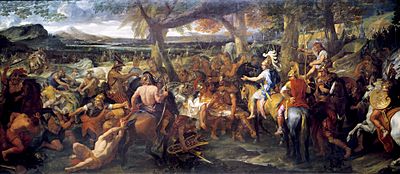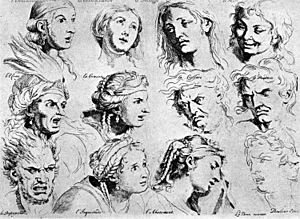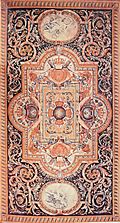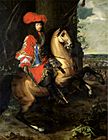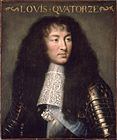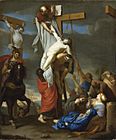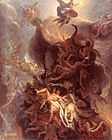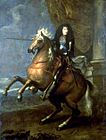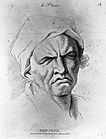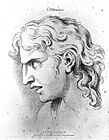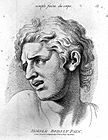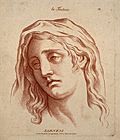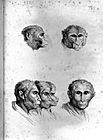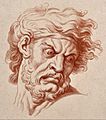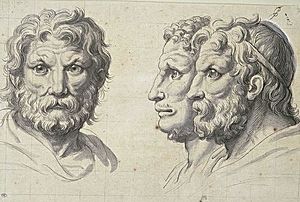Charles Le Brun facts for kids
Quick facts for kids
Charles Le Brun
|
|
|---|---|
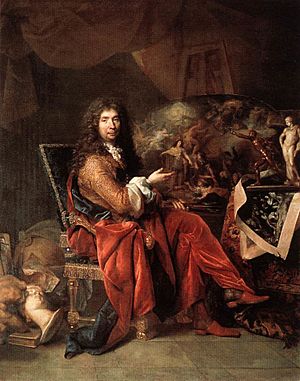
Charles Le Brun, portrait by Nicolas de Largillière
|
|
| Born | 24 February 1619 Paris, France
|
| Died | 22 February 1690 (aged 70) Paris, France
|
Charles Le Brun (born 24 February 1619 – died 12 February 1690) was a famous French painter. He was also a physiognomist (someone who studies faces to understand character) and an art theorist. He led several important art schools during his time.
As the official court painter for King Louis XIV, Charles Le Brun was a very important artist in France in the 1600s. King Louis XIV even called him "the greatest French artist of all time." Le Brun was greatly influenced by another famous painter, Nicolas Poussin.
Contents
About Charles Le Brun
His Early Life and Training
Charles Le Brun was born in Paris. When he was just eleven years old, a powerful official named Chancellor Séguier noticed his talent. Séguier helped Le Brun join the art studio of Simon Vouet. He also learned from another painter, François Perrier.
By age fifteen, Le Brun was already getting important jobs from Cardinal Richelieu. His skill impressed Nicolas Poussin, and in 1642, Le Brun traveled to Rome with Poussin.
Studying Art in Rome
Le Brun stayed in Rome for four years. He received money from Chancellor Séguier to support his studies. In Rome, he worked with Poussin and learned about his ideas on art. Le Brun also studied ancient Roman sculpture and copied paintings by Raphael. He learned a lot from the local painters there.
When he returned to Paris in 1646, many people wanted Le Brun to paint for them. One of his most important supporters was Superintendent Fouquet. Le Brun painted a large picture of Anne of Austria for him. He also worked at a grand estate called Vaux-le-Vicomte. While there, he became friends with Cardinal Mazarin, who was secretly working with Jean-Baptiste Colbert against Fouquet.
Leading French Art Schools
Le Brun was a key person in starting the French Royal Academy of Painting and Sculpture in 1648. He was chosen as one of the first twelve leaders of the Academy. He became a very powerful figure there. He held important roles like chancellor and director for many years.
When Colbert took charge of the Academy in 1661, Le Brun helped him reorganize it. Their goal was to create a strong foundation for French art. They also started the Academy of France at Rome in 1666. This school allowed talented young artists to live and learn in Rome at the king's expense.
Le Brun also worked on decorating the Hôtel Lambert. He painted the ceiling in the Hercules gallery. This project began in 1650 and continued for about twelve years.
In 1660, Le Brun and Colbert also set up the Gobelins. This was a famous workshop that made not only tapestries but also all kinds of furniture for the royal palaces. Le Brun was the director of the Gobelins. He also controlled the art world through the Academy. Because of this, he shaped almost all art made in France during his lifetime. He created the "Louis XIV Style" which influenced French art for centuries.
Working for the King
Le Brun's grand and impressive style perfectly matched the taste of King Louis XIV. The king loved Le Brun's paintings for his grand entry into Paris in 1660. He also admired Le Brun's decorations at the Château Vaux le Vicomte in 1661.
The king then asked Le Brun to paint a series of pictures about the life of Alexander the Great. The first painting, "Alexander and the Family of Darius," pleased King Louis XIV so much that he made Le Brun a nobleman in 1662. Le Brun was also named First Painter of the King. He received a large yearly payment. The King truly believed Le Brun was "the greatest French artist of all time."
Art for the Royal Palaces
From this time on, Le Brun was in charge of all art projects in the royal palaces. The king had to approve all designs before they became paintings or sculptures. In 1663, Le Brun became the director of the Royal Academy. He set the rules for what is known as academicism. This made him the most powerful art master in 17th-century France.
During this time, he continued his series on Alexander the Great, called The Battles of Alexander The Great. He used these paintings to show how magnificent King Louis XIV was, just like Alexander. As he worked on these battles, Le Brun's style became more unique.
Work on the Gallery of Apollo in the Louvre was paused in 1677. This was because Le Brun went with the king to Flanders. He also painted several works at the Château de Saint-Germain-en-Laye. His biggest projects were at Versailles. There, he decorated the Halls of War and Peace, the Ambassadors' Staircase, and the famous Great Hall of Mirrors (1679–1684). Le Brun's art at Versailles is not just beautiful; it tells the story of King Louis XIV's reign.
In 1669, King Louis XIV decided to completely rebuild Versailles. It was a small palace then, but he wanted to make it a grand place for meetings. Le Brun was in charge of every small detail of its decoration. Besides classical paintings, the palace walls also showed scenes from Louis's reign. The whole design was meant to impress visitors with the king's wealth and good taste. The Escalier des Ambassadeurs (Ambassadors' Staircase) was the main entrance staircase at Versailles. The king loved it so much that he called it "Monsieur Le Brun's staircase."
His Later Years
After Colbert died, a new official named François-Michel le Tellier, Marquis de Louvois took over public works. He did not favor Le Brun, who had been Colbert's favorite. Even though the king still supported him, Le Brun felt things had changed. This sadness contributed to an illness that led to his death on 22 February 1690, in his home in Paris.
Charles Le Brun's Art and Influence
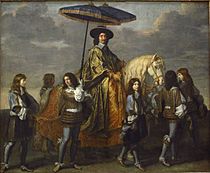
Le Brun mostly worked for King Louis XIV. He painted large altarpieces (paintings behind altars) and battle pieces for the king. His most important paintings are at Versailles. Besides his huge projects at Versailles and the Louvre, he also created many works for churches and private people.
Le Brun was also a good portrait painter and an excellent artist at drawing. However, he didn't really enjoy painting portraits or landscapes. He felt these were just ways to practice technical skills. For him, the most important thing was creating scholarly compositions. These paintings were meant to teach and inspire the mind.
Le Brun believed that a painting should tell a story. He used symbols, costumes, and gestures to add deep meaning to his works. For him, a painting was like a book you could read. Many of his paintings were later copied by famous engravers.
After he died, a book of his ideas was published called Méthode pour apprendre à dessiner les passions (1698). In this book, he explained how to show emotions in paintings. Le Brun's ideas about emotions, or "passions" as they were called then, were influenced by the philosopher René Descartes. He showed different facial expressions as a guide for other artists. People believed these expressions showed what was happening in a person's soul. His ideas greatly influenced art theory for the next two centuries.
Many of Le Brun's drawings are kept in the Louvre Museum and the Monaco Royal Collection. He also taught another painter named Ludovico Dorigny.
The beautiful Baroque ceiling in the Muses Room at the Chateau Vaux-le-Vicomte was decorated by artists from Charles Le Brun’s workshop. Many of Le Brun's designs were later painted or sculpted by artists working for him. This ceiling was restored in 2017.
In 2013, art experts found an early painting by Le Brun called The Sacrifice of Polyxena. This painting, from 1647, was found in the Coco Chanel suite of the famous Hôtel Ritz Paris and had been unnoticed for over a century.
After his death, Le Brun's fame decreased, especially around the time of the French Revolution. This was because he was so closely linked to King Louis XIV. By the late 1800s, his style of art was not popular. However, in 1963, a big exhibition of his work was held at Versailles. This helped people see his art in a new way. Today, he is considered one of the best and most skilled French artists of his time.
Some of His Famous Works
Decorations:
- Ceiling of the Galerie d'Apollon at the Louvre Palace.
- Decorations at the château de Vaux-le-Vicomte, including the King's room.
- Dome of the Pavillon de l'Aurore at the château de Sceaux.
- Murals on the ceiling of the Galerie des Glaces at the Palace of Versailles.
- Apotheosis of Romulus, a series of eight paintings for a room ceiling in the Hôtel d'Aumont, Paris.
Paintings:
- The Sleep of Jesus, musée du Louvre.
- Chancellor Séguier and his suite, musée du Louvre.
- Paintings from the Story of Alexander, musée du Louvre.
- Louis XIV presenting his sceptre and his helmet to Jesus-Christ, musée des beaux-arts de Lyon.
- A series of four paintings: Air, Earth, Fire and Water, Musée des Beaux-Arts et d'Archéologie de Châlons-en-Champagne.
Publications:
- Méthode pour apprendre à dessiner les passions (1698), published after his death.
Gallery
-
Bassin d'Apollon at the Palace of Versailles, 1668–1671. Le Brun designed the centerpiece depicting Apollo rising from the sea in a four-horse chariot.
=Images for kids
See also
 In Spanish: Charles Le Brun para niños
In Spanish: Charles Le Brun para niños


